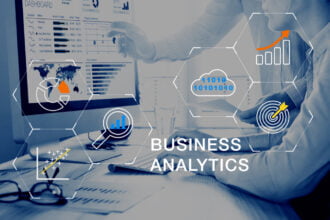The ETL process is defined as the movement of data from its source to destination storage (typically a Data Warehouse) for future use in reports and analyzes. The data is initially extracted from a vast array of sources before transforming and converting it to a specific format based on business requirements.
ETL is one of the most integral processes required by Business Intelligence and Analytics use cases since it relies on the data stored in Data Warehouses to build reports and visualizations. This helps in building effective strategies that can provide actionable and operational insights.
Understanding the ETL Process
Before you understand what is ETL tool, you need to understand the ETL Process first.
- Extract: In this step, data is extracted from a vast array of sources present in different formats such as Flat Files, Hadoop Files, XML, JSON, etc. The extracted data is then stored in a staging area where further transformations are carried out. Therefore, the data is thoroughly checked before loading onto a Data Warehouse. You will need a Data Map between the source and target because the ETL process needs to interact with various systems along the way.
- Transform: This step is considered the most important step of the ETL process. There are two types of transformations that can be carried out on the data: Basic Transformations like Consolidation, Filtering, Data Cleansing, and Standardizations or Advanced Transformations like Duplication, Key Restructuring, and Using Lookups to Merge Data.
- Load: In this step, you load the transformed data into the Data Warehouse, where it can be leveraged to generate various reports and make key analytical decisions.
Types of ETL Tools
Here are the different types of ETL Tools that you can leverage for your business:
Open Source ETL Tools
Over the last decade, software developers have come up with various Open-Source ETL products. These products are free to use and their source code is freely available. This allows you to enhance or extend their capabilities. Open-Source tools can vary considerably in integrations, quality, adoption, ease of use, and availability of support. A lot of Open-Source ETL tools house a graphical interface for executing and designing Data Pipelines.
Here are few best Open-Source ETL tools on the market:
- Hadoop: Hadoop distinguishes itself as a general-purpose Distributed Computing platform. It can be used to manipulate, store, and analyze data of any structure. Hadoop is a complex ecosystem of Open-Source projects, comprising over 20 different technologies. Projects like MapReduce, Pig, and Spark are used to perform key ETL tasks.
- Talend Open Studio: Talend Open Studio is one of the most popular Open-Source ETL tools on the market. It generates Java code for the Data Pipelines instead of running Pipeline configurations through an ETL Engine. This unique approach lends it a couple of performance advantages.
- Pentaho Data Integration (PDI): Pentaho Data Integration is well known in the market for its graphical interface, Spoon. PDI can generate XML files to represent Pipelines, and execute those Pipelines through its ETL Engine.
Enterprise Software ETL Tools
There are numerous software companies that support and sell commercial ETL software products. These products have been around for quite a long time and are generally mature in functionality and adoption. All the products provide graphical interfaces for executing and designing ETL Pipelines and connect to relational databases.
Here are the few best Enterprise Software ETL tools on the market:
- IBM Infosphere DataStage: DataStage is a mature ETL product that depicts strong capabilities for working with mainframe computers. It is considered a “complex to license and expensive tool” that often overlaps with other products in this category.
- Oracle Data Integrator: Oracle’s ETL product has been in the market for several years now. It utilizes a fundamentally unique architecture from other ETL products. As opposed to performing transformations in the ETL tool itself using hardware resources and a dedicated process, Oracle Data Integrator moves data into the destination first. It then performs transformations using the Hadoop cluster or the features of the database.
- Informatica PowerCenter: Informatica PowerCenter is leveraged by various large companies and is well regarded by industry analysts. It is part of a larger suite of products, bundled as the Informatica Platform. These products are IT-centric but quite expensive. Informatica is deemed less mature than some other products on the market for unstructured and semi-structured sources.
Cloud-based ETL Tools
Cloud-based ETL Tools have the advantage of providing robust integrations to other Cloud services, use-based pricing, and elasticity. These solutions are also proprietary and work only within the framework of the Cloud vendor. Simply put, Cloud-based ETL tools cannot be used in a different cloud vendor’s platform.
Here are the few best Cloud-based ETL tools on the market:
- Hevo Data: A fully managed No-code Data Pipeline platform like Hevo Data helps you integrate data from 100+ data sources (including 30+ Free Data Sources) to a destination of your choice in real-time in an effortless manner. Hevo with its minimal learning curve can be set up in just a few minutes allowing the users to load data without having to compromise performance. Its strong integration with umpteenth sources allows users to bring in data of different kinds in a smooth fashion without having to code a single line.
- Azure Data Factory: This is a fully managed service that connects to a wide range of On-Premise and Cloud sources. It can easily transform, copy, and enrich the data, finally writing it to Azure data services as a destination. Azure Data Factory also supports Spark, Hadoop, and Machine Learning as transformation steps.
- AWS Data Pipeline: AWS Data Pipeline can be used to schedule regular processing activities such as SQL transforms, custom scripts, MapReduce applications, and distributed data copy. It is also capable of running them against multiple destinations like RDS, DynamoDB, and Amazon S3.
Conclusion
This blog talks about the basics of ETL and ETL tools. It also gives an insight into a couple of the best ETL tools in the market belonging to each category of ETL tools.










